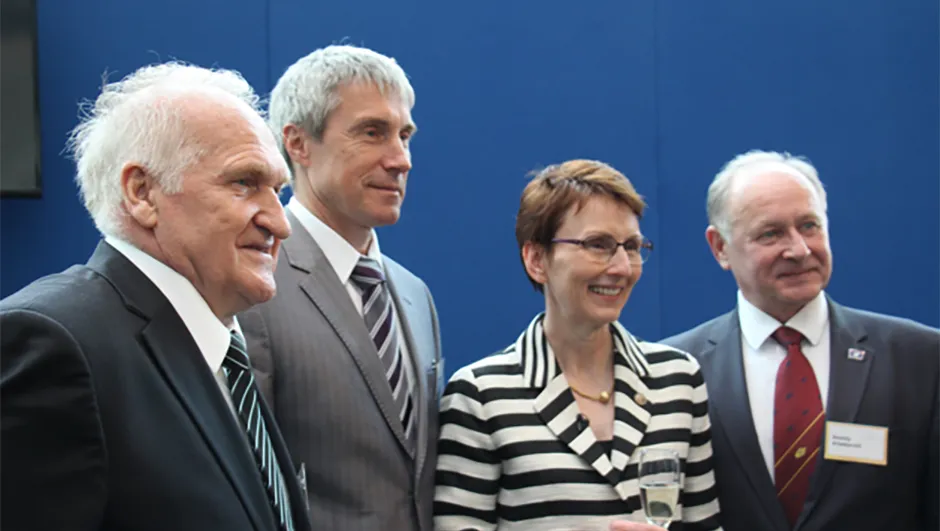Sharman and Mogensen talk with Tim Peake live from the International Space Station
First Briton in space, Helen Sharman, reunited with her crew on 20 May to celebrate the 25th anniversary of her docking with space station Mir. Sharman – who flew as part of Project Juno – reminisced with her old colleagues Anatoly Artsebarsky, Sergi Krikalev and Viktor Afanasyev about the flight at an event held at Imperial College London, which included a live link to currently serving UK astronaut Tim Peake on-board the International Space Station.
Sharman launched on-board a Soyuz capsule on 18 May 1991 along with Artsebarsky and Krikalev.
"I remember quite distinctly that as the gantry pulled back there was just enough thrust to hover above the ground.
I remember the rocket swaying around a little bit before the thrust built up enough to launch.
It's very lumpy and bumpy as the rocket stages go off," said Sharman.
"But once you're out of the atmosphere and the faring jettisoned, that's the first time you can see out the window.
I was sitting on the right of the space craft with a window looking down on Earth, so I had to recount to the others what the Earth looked like as we were going to space.
As soon as you start to feel weightless though, that's when you start to enjoy it a bit more."

The Soyuz docked two days later on 20 May. Sharman stayed on the station only six days before having to return to Earth.
Crewmate Afanasyev recalled that the day before she had to leave, he found Sharman crying, knowing she would not have the opportunity to return.
"One of the reasons I was sad was because I was leaving behind a great crew," said Sharman.
"Saying good bye was one of the hardest things I've ever had to do in my life.
Getting into space was easy, saying goodbye was the hard part."
Sharman never returned to space, and it would take another 25 years for an astronaut to fly under the Union Jack. UK astronaut Tim Peake is currently serving on board the ISS and phoned in to talk to Sharman, and fellow member of the 2009 astronaut class, Andreas Mogensen.
"As much as I would like to be with all of you tonight celebrating, I'm actually rather glad I'm not," said Peake.
"So many of you know that space is actually the best place you could possibly be.
Finally 25 years after Sharman's expedition there's another Union Flag being worn in space.
I know that's something she campaigned for long and hard, and for that I'm grateful."
Project Juno
While Sharman and Peake may have been the only people with sole British citizenship to fly in space, there were many other people who shared their dream, including the other finalists for Project Juno who attended the event.
They recalled Sharman’s promise even during early training.
After g-force exercises on a centrifuge, most applicants came off struggling to hold onto their lunch, but Sharman bounced away, exhilarated by the experience.
But despite being the perfect candidate, Sharman almost didn’t get to fly at all.
Unlike most space missions, Project Juno was devised as a money making venture, where the trip would be paid for by private sponsorship as at the time the government was not interested in human spaceflight.

But the mission failed to generate the interest hoped for.
One of the final four Juno candidates, Gordon Brooks, witnessed first hand the difficulties that arose around the mission.
“The team behind it wanted to make a superstar,” said Brooks.
“There was going to be a game show to select the final astronaut, but when the Russian’s started talking about all their requirements the Project Juno team realised it wasn’t going to work.
In the end it was more like a comedy show, it was so unorganised.”
Luckily things have changed in the 25 years since Sharman’s flight.
While Tim Peake is the first government sponsored UK astronaut, it’s hoped that he will not be the last.
Hopefully by the end of the next 25 years, the Union Flag will have become a familiar sight on the ISS, and many other Brits will have joined Sharman and Peake in space.
